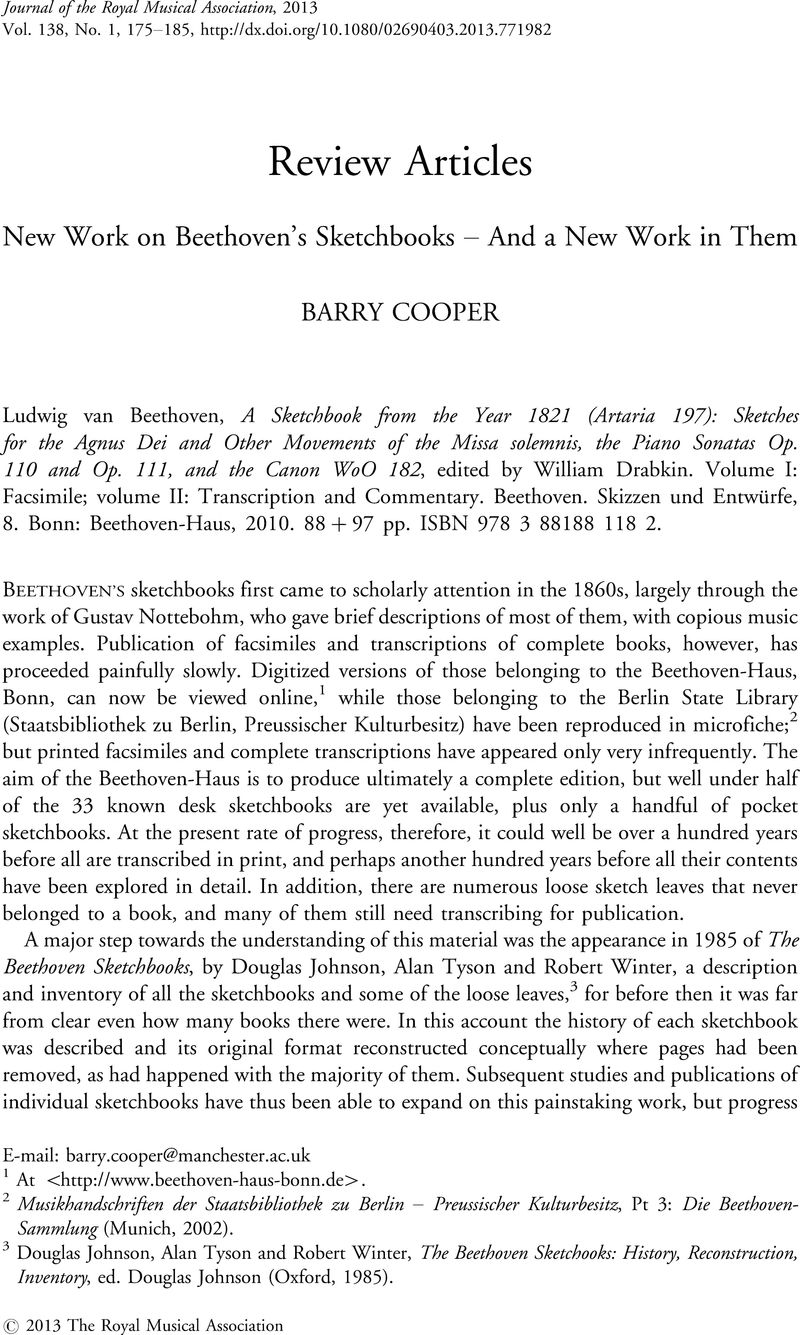No CrossRef data available.
Published online by Cambridge University Press: 01 January 2020

2 Musikhandschriften der Staatsbibliothek zu Berlin – Preussischer Kulturbesitz, Pt 3: Die Beethoven-Sammlung (Munich, 2002).
3 Douglas Johnson, Alan Tyson and Robert Winter, The Beethoven Sketchooks: History, Reconstruction, Inventory, ed. Douglas Johnson (Oxford, 1985).
4 Ludwig van Beethoven, Artaria 195: Beethoven's Sketchbook for the Missa solemnis and the Piano Sonata in E Major, Opus 109, ed. William Kinderman, 3 vols. (commentary; facsimile; transcription) (Urbana and Chicago, IL, 2003).
5 Hans-Günter Klein, Ludwig van Beethoven: Autographe und Abschriften, Staatsbibliothek Preussischer Kulturbesitz: Kataloge der Musikabteilung, I/2 (Berlin, 1975), 190–201.
6 Klein, Ludwig van Beethoven, 191.
7 The music has actually been identified once before, in Joseph Schmidt-Görg, ‘Das gregorianische Pange-lingua bei Beethoven: Ein neuer Fund’, Der kultische Gesang der abendländischen Kirche, ed. Franz Tack (Cologne, 1950), 109–11. Schmidt-Görg, however, did not recognize it as an essentially complete and performable work, and his article appears to have been overlooked in all subsequent literature on Artaria 197.
8 The Liber usualis with Introduction and Rubrics in English, ed. the Benedictines of Solesmes (Great Falls, MT, 1997), 950 (Dorian mode) and 957 (Phrygian mode). Earlier editions of the Liber usualis include the same two versions. They are derived from medieval manuscripts, but the editors do not indicate which ones.
9 ‘Um wahre Kirchenmusik zu schreiben alle Kirchenchoräle der Mönche etc. durchgehen’; see Maynard Solomon, ‘Beethoven's Tagebuch of 1812–1818’, Beethoven Studies 3, ed. Alan Tyson (Cambridge, 1982), 193–288 (pp. 283–4; translation altered).
10 The sketches are edited in Ludwig van Beethoven: Autograph Miscellany from Circa 1786 to 1799: British Museum Additional Manuscript 29801, ff. 39–162 (The ‘Kafka Sketchbook’), ed. Joseph Kerman, 2 vols. (London, 1970), ii, 131–3.
11 ‘Ich habe auch Orgel gespielt, das Pange lingua, Herr deiner Kirche Glieder etc, aber mit Generalbass war ich noch nicht sehr weit’; see Ludwig van Beethovens Konversationshefte, 11 vols. (Leipzig, 1968–2001), i, ed. Karl-Heinz Köhler and Grita Herre (1972), 393. I am grateful to Susan Cooper for drawing my attention to this entry.
12 Sieghard Brandenburg, ‘The Historical Background to the “Heiliger Dankgesang” in Beethoven's A Minor Quartet Op. 132’, Beethoven Studies 3, ed. Tyson, 161–91.
13 See Barry Cooper, Beethoven's Folksong Settings: Chronology, Sources, Style (Oxford, 1994), 129.
14 Brandenburg, ‘The Historical Background to the “Heiliger Dankgesang”’, 173–4.
15 Daniel Gottlob Türk, Von den wichtigsten Pflichten eines Organisten (Halle, 1787), 44–5; cited in Brandenburg, ‘The Historical Background to the “Heiliger Dankgesang”’, 173.
16 Brandenburg, ‘The Historical Background to the “Heiliger Dankgesang”’, 173.
17 See Cooper, Beethoven's Folksong Settings, 208–9.
18 See Barry Cooper, Beethoven and the Creative Process (Oxford, 1990), 20–1.